
Bilbo has his doubts, but that’s really none of his business.
Yora's site for Sword & Sorcery RPGs

Bilbo has his doubts, but that’s really none of his business.
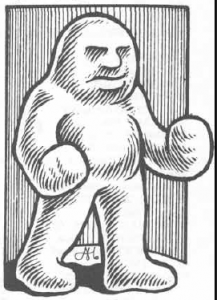
The Enveloper is some kind of gooey creature that has the ability to absorb people it killed and gain its abilities and knowledge. Which each new victim it simply adds its abilities to those it already has and gets tougher and stronger. It may look like the Michelin Man, but otherwise has more similarities with The Thing. It doesn’t seem to be able to change its appearance to that of a person it absorbed, though.
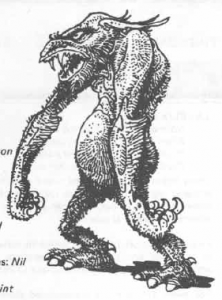
Ettercaps are primitive humanoids with a poisonous bite and the ability to create webs like spiders. They use the substance as building material for all kinds of traps. Their nature also makes them go along well with spiders. Ettercaps did show up in all following editions of D&D, as far as I am aware, later on becoming quite spider-like themselves, but there isn’t anything of that in this original version. The bug eyes started in AD&D 2nd edition and this aspect was build up increasingly ever since.
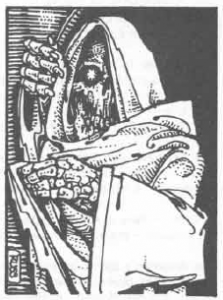
The Eye of Fear and Flame is another skeleton wrapped in a robe and stalks the underworld to do evil deeds to lawful characters. No real reason why, but it just does. In it’s natural state, the face is hidden inside the hood by supernatural darkness, but if anyone tries to resist its commands, it will remove its hood, revealing its bare skull with two gems as eyes. One red and one black. The red eye can cast a fireball spell every three rounds. And the black eye, you guessed it, casts a fear spell. Trying to cast spells to blind it at the creature will simply reflect them at the person who cast them. It can’t really fight in other ways and when it’s starting to lose it will try to escape to the ethereal plane, though that takes it two rounds to do so, which can be quite plenty of time to destroy it. At 12 hit dice and armor class 2, it’s pretty tough, though. This is another creature that sounds like it was really cool when it was originally used by the person who created it, but without knowing that story, it seems a bit random. And I guess the name is pretty cool, too. Continue reading “Fantasy Safari: Fiend Folio (AD&D 1st Edition), Part 3”
Yes, it’s been a while. Quite a while.
But I recently got a couple of monster books I want to share with people, and instead of going straight to those, I first want to complet this run of the Fiend Folio.
So, here we go, picking up where we last left:
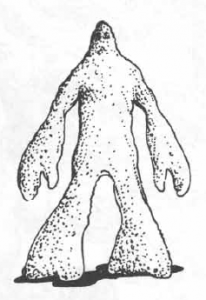
The Cifal is a form of “colonial insect-formed artificial life”. Yeah, this one pretty certainly is one of the submissions to White Dwarf magazine. It’s a swarm of insects that has combined into a single humanoid form. When damaged, the creature will burst apart and transform into a swarm of flying insects which do not attack, but reassemble into a new form after a short time. By hitting it quickly it can immediately be dispersed again, but with every round it regenerates 2 hit points. Repeating that process long enough will eventually kill it, as it can’t regenerate indefinitly, but it seems a much better idea to try to kill the swarm with fireballs or something like that.
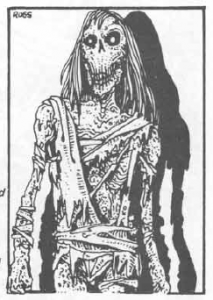
The Coffer Corpse looks like a zombie and is always found in some kind of coffin. If the coffin is opened, it will immediately wake up and try to strange the person who opened the lid and will not let go until destroyed. If it takes 6 points of damage in a single round, it collapses as if dead, but will get back up on its feet the next round (which I believe is 1 minute in this game), which causes anyone nearby to make a saving throw or flee in terror. The coffer corpse does not actually regenerate any damage, though.
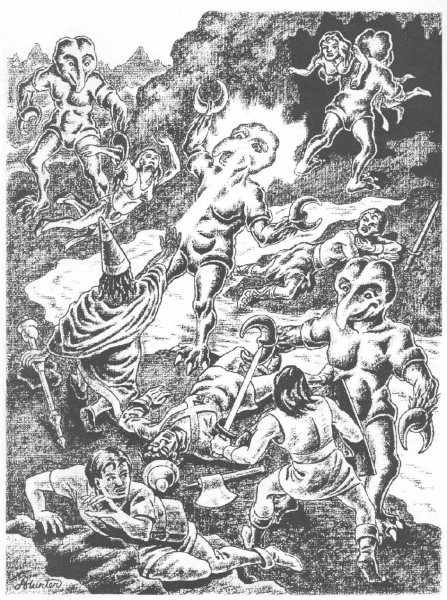
Crab People, Crab people! Tastes like crab, talk like people! Continue reading “Fantasy Safari: Fiend Folio (AD&D 1st Edition), Part 2”
“Historians/Archeologists suck at naming things” is kind of an old joke, but when it comes to Star Wars it’s even worse. Much, much more worse. Things are certainly not helped by the fact that it’s always the same four groups fighting the same conflict over and over. But seriously, how much more terrible could writers possibly be at naming these wars?
Seriously! The fuck?!
Well, I guess that means we should get ready for the New Mandalorian War, the Jedi-Empire War, and the Great Republic War.
Worldbuilding for dummies. First lesson: Don’t do this!
In the world of the Ancient Lands, there is only a single supernatural force at work. Life force, magic, spirits, souls; it’s all the same basic energy that is found inside and between everything. This energy is what gives living creatures their strength and make them grow and heal injuries and disease. It is also what creates the souls of mortal creatures and in places where the energies of the landscape are strong, they manifest in sentient spirits of great power.
The arts of magic are the mastery of the ability to not just call on the life energy within oneself, but to extend ones mental control to the energies around one and even inside other objects and beings. When casting a spell, a mage is sending a ripple through the energies surrounding him to manipulate the energies within creatures and objects to his desire, just as normal people control the energies within their arms and legs. Magic spells can make plants grow or move, split or shove away rocks, create lightning and set things on fire, and even take some control over other creatures thoughts. To be able to manipulate the life force and magical energies at a distance, mages needs to build up a reserve of energy separate from their own life force, which they accomplish by many years of training and meditation. Once this reserve is spend, they can no longer cast any spells until the energies are restored. People who have mastered magic, and creatures that are naturally magical, require almost no effort to regain their spend magical energy. Their energy reserve has become a natural part of their own being and during rest energies from the surrounding environment automatically move in to fill the void and restore the natural balance of energies. Compared to the amounts of energy in the natural world, even the most powerful spellcasters can store only such a small amount that there is no noticable drain of life force in the creatures and plants arround them.
In the earliest days of the mortal races, the magical abilities of spirits and other magical creatures was not yet entirely understood and the earliest mages did not yet have the ability to create reserves of magical energies to power their spells. But they realized that magical energy and life force is essentially the same and in no other part of a mortal creature is its life force as strong and concentrated as in the blood. Not only could these early mages use the energy in their own blood to cast their spells, they could also use the life force of other living creatures.
When the more common forms of magic were discovered, this blood magic was soon abandoned. The storing of magical energies from the environment is not only much more effective, but also much less painful and gruesome. However, unlike many shamans and witches would like to believe, the traditions of blood mages never entirely disappeared and continued to exist in some small remote places for all the thousands of years. Pure, traditional blood mages are almost unheard of in the present age. The advantages of using the magical energies of the surrounding natural world are just too great for any mage to ignore. But there are still some advantages to blood magic, which allowed the ancient traditions to survive. By drawing the life force from their own blood, blood mages can significally extend their reserves of magical energy and even make their spells stronger and more powerful than they would usually be able to. And by using the life force of other living creatures, blood mages can have access to vast amounts of magical energy for prolonged rituals and large scale magical effects, that would take ordinary mages days or week. Because of the violent and gruesome nature of blood magic, most people regard it as savage and horrific, but contrary to common believes, blood magic itself does not have a corrupting effect on those who use it or are affected by it.
Outside the natural world that consists of the material world and the Spiritworld exists a realm of infinite time and space that is simply called the Void. Just as there are spirits in the natural energies of the spiritworld there are also beings born from concentrations of the energies of the Void, called demons. When mages learn a way to create a connection to the Void, it allows them to draw some of its energies to their own world and use it as an additional source of magical power in addition to their own. With these energies they can create spells that can not be cast with magical energies of the natural world and it also greatly increases the number of spells they can cast before their reserves are exhausted.
However, the natural world and the Void are realms of completely different laws that are conflicting with each other and bringing energies from the Void into the natural world causes it to become warped and twisted, an effect known as corruption. The demonic energies are toxic to any living things that are affected by it. Mages who have mastered their use can learn to resist its effects and may show only very little signs of the massive exposure they recieve from many years of casting demonic spells. However the land around their homes and lairs becomes significantly affected, making these places hostile to all living things, turning them weak and sick and eventually killing them.
But corruption is not simply a drain of life force, but a warping and twisting of it, and corrupted life force is still able to support life, at least in a manner of speaking. When creatures becomes entirely corrupted but do not simply fall dead, they turn into the undead. Zombies and skeletons are corpses that have become powered by corrupted energy after their death, while those who have never really died become ghouls or wights. In rare cases, a person dies but the corrupted energies that have been part of him continues to exist as a faint afterimage of a creature known as a shadow. When the corruption has been so complete that the soul itself has become corrupted, it continues to exist even after the body has died as a wraith.
I believe I’ve found what is possibly the worst name and book cover for an RPG I’ve ever come across.
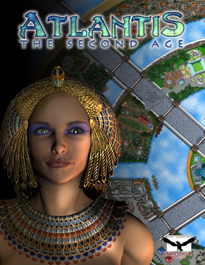
Doesn’t look so terrible? You probably think you’ve seen far uglier things before. But this isn’t about beauty, but appropriateness. The game is called Atlantis: The Second Age. What does that make think you off? A utopian society from the Golden Age of Greek mythology where people were enlightened and lived in pleasure and luxury? And look at the cover art. This women decked out in jewelry and in the background a map of a precisely geometrically constructed city with parks and palaces.
But why is this so terrible? Think about the assumptions you make what this game is like and how it plays? It certainly does not say action-packed Sword & Sorcery based entirely around mechanics that encourage and reward the players for outragous stunts and hot-blodded carnage, where your characters grow in power based on the awesomeness of their heroic deeds. A world where you can play as a hyper-intelligent gorilla with guns? But that’s what you actually get once you make it behind this cover and take a look at what’s inside.
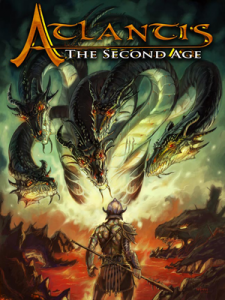
The recently released second edition still carries over the legacy of this unfortunately boring name, but look at the cover! This is awesome! So much more better than the first edition that was the incarnation of boring. This one captures perfectly what this game is all about. Being a total badass slaying legendary monsters and adding their feared reputation to your own glory.
I quite like Barbarians of Lemuria as a lightweight Sword & Sorcery game. And while Atlantis is significantly rules heavier (though still quite moderate), there is so much more flavor and incentive to actually play an over the top Sword & Sorcery hero.
And let my say it again: Hyper-intelligent gorillas. With guns!